The humble hoverfly – a fascinating insect with a lot more to it than gardeners might think.
Indeed, there are actually around 6,000 species of hoverfly in 200 genera.
These often-overlooked insects are captivating and intriguing.
Read on to find out everything you need to know about these little garden beasties.
Hoverflies
The hoverfly, flower fly or syrphid fly is a member of the Syrphidae insect family in the fly order Diptera.
Most commonly called hoverflies, they get their range of nicknames from their behavior as they are commonly seen hovering over flowers to get to their nectar.
Appearance
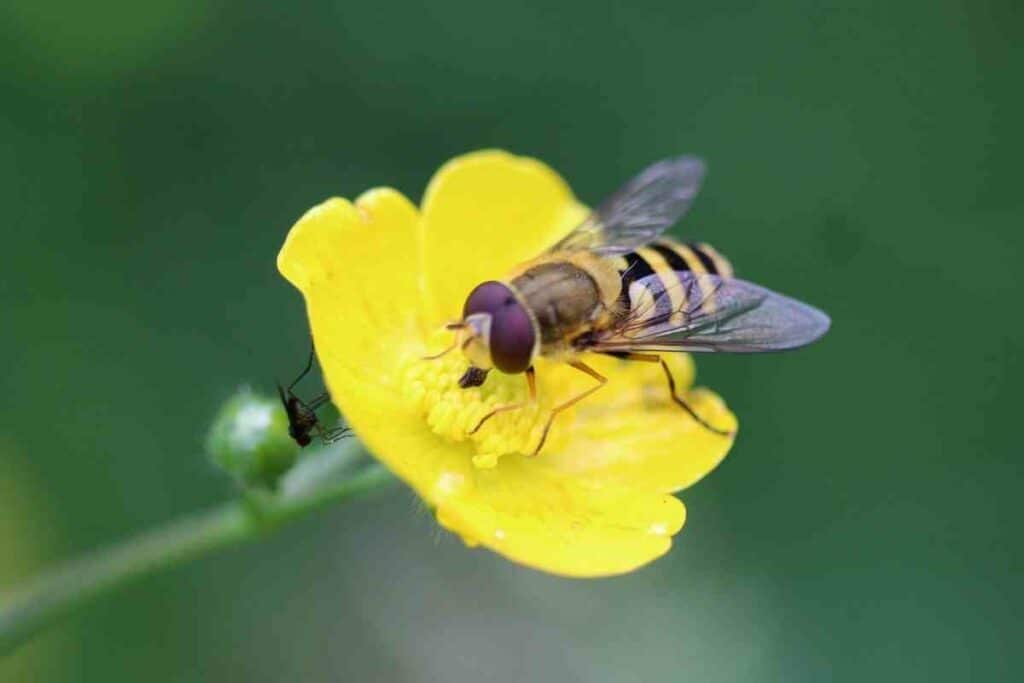
Mimicry
Often mistaken for a wasp or a bee to the untrained eye, hoverflies have distinct yellow and black markings, but they do not sting or bite.
In fact, they are pretty harmless to most mammals. However, some species do mimic bees and wasps quite remarkably, which may be to ward off any predators.
In the genus Eristalis, some drone flies look just like honeybees whereas Volucella inansis looks like a hornet. V. bombylans is another convincing mimic of a bee.
Wings
Hoverflies can be distinguished from other types of fly thanks to their spurious (false) vein which lies almost in parallel to the fourth longitudinal wing vein.
They have a single pair of wings as their hind wings are simply halteres – balancing organs that help the flies to maintain and correct its position, providing feedback to the steering muscles in the wings.
The wings are usually clear with the veins merging at the rear to create a ‘false rear edge’ that runs alongside the real rear edge and extends at least halfway along the wings.
Markings
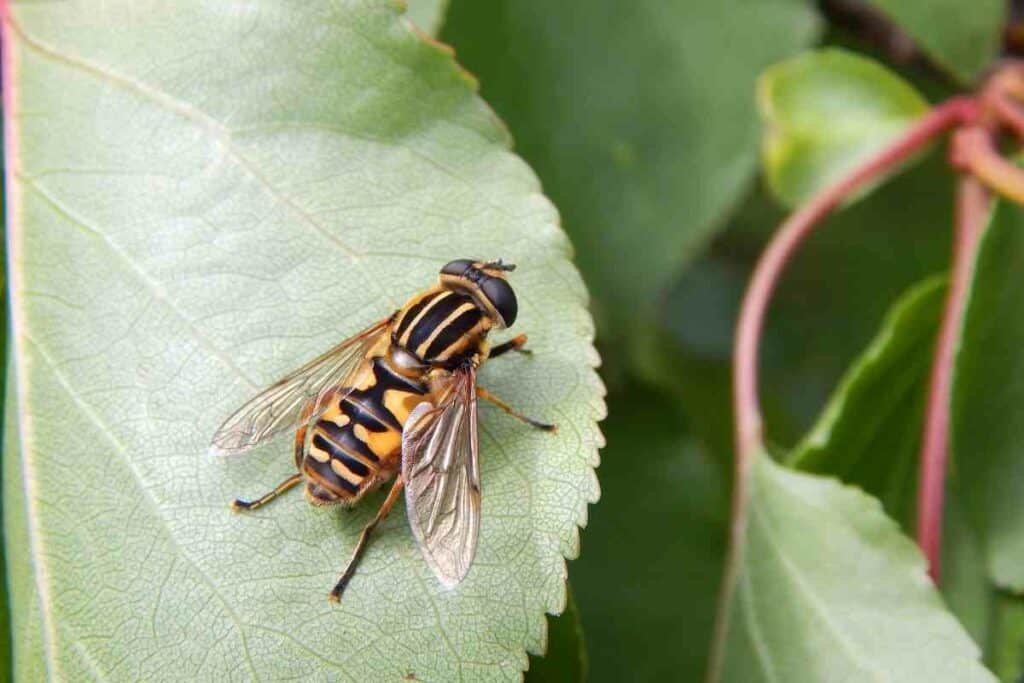
The different species of hoverfly have different markings and can vary from large, yellow, and black hairy varieties (Criorhina) to tiny, slender, and elongated ones (Baccha).
The bright colors can appear in the form of bands of brown and yellow, stripes, and even spots.
Unique features
Aside from these, hoverflies also have a few other unique features.
Their mouthparts and legs are not usually long or thin unlike some bombyliids).
Also, there are often a beak and/or prominent bulges or small projections on their facial cuticle, unlike bees who have sloping or evenly curved faces.
Additionally – Their thoraces and abdomens are usually glossy on the surface and their colors are largely thanks to cuticular pigments, unlike bees whose color is normally due to hair pigmentation.
The Hoverfly Lifecycle
Similar to other fly species, the hoverfly lifecycle has the egg, larva, pupa, and imago (adult) stages.
Adults typically mate whilst pollinating flowers and searching for nectar. The females look for colonies of insects on plants to lay their eggs.
They then lay their eggs underneath leaves or on plant stems so that, when they hatch, their larvae can find an abundance of insects straight away.
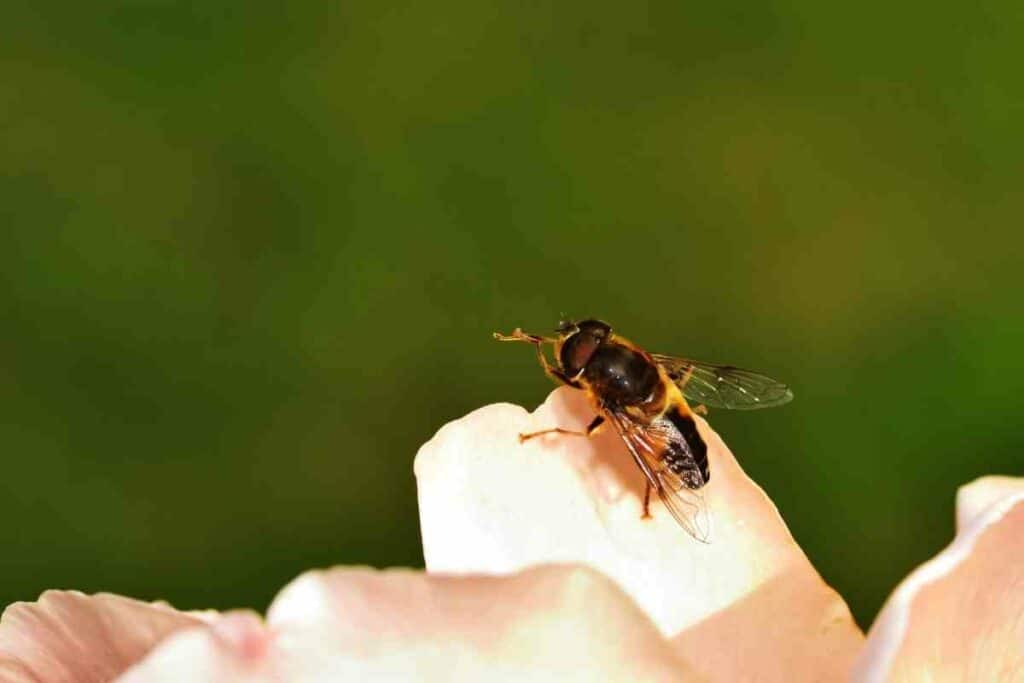
When the eggs hatch, they feast on these insects for about a week.
Some hoverfly larvae have adapted to life in dirty and stagnant water. They have developed a pipe at the rear of their bodies that sticks out into the air.
Whilst most hoverfly larvae eat aphids or plant lice (more than 110 species), around 33 known species live on trees and survive on tree sap or decaying wood.
After the Larvae Stage – They often fall from the leaves into the soil. They will pupate for about two weeks to become adults.
The pupa changes color from green to the adult hoverfly color and becomes more pear-shaped rather than rectangular.
After two weeks, the hoverflies emerge. There can be between three and seven generations of hoverflies every year.
Diet
Feeding mainly on pollen and nectar as adults, hoverfly larvae have a wider variety to their diet.
Some species of hoverfly have larvae that are saprotrophs, meaning they eat decaying animal and plant matter in ponds, streams, and soil.
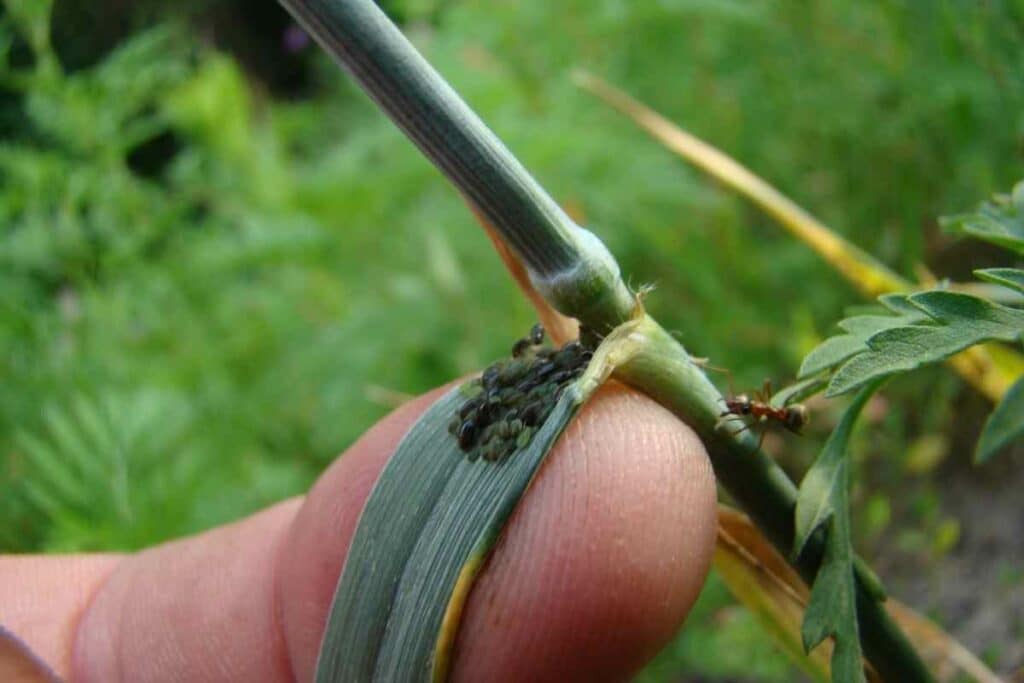
Other species have larvae that eat insects such as thrips and aphids.
Given that many aphids are considered pests to crops, hoverfly larvae can actually be beneficial to growers of produce, working well as an ecological and economical predator.
The adults then work as great pollinators too.
Habitat and Distribution
Hoverflies are found in most climates except the most extreme such as high altitudes, tundra, deserts, and in Antarctica.
Some species of hoverfly are more commonly found in certain areas compared with others.
The American hoverfly (Eupeodes americanus) is commonly found in North America (the Nearctic realm) whereas the common hoverfly (Melangyna viridiceps) is more common in Australasia.
As Mentioned – Some hoverfly larvae are aquatic and prefer stagnant water. Other species find more unusual homes such as bumblebee nests (hoverflies that are members of the Volucella genus) or termite and ant nests (Microdon varieties).
It’s also common to find them in decomposing material.
Benefits to Gardeners
Despite many of the general public being a little wary of hoverflies as they buzz around them in search of food, resembling their stinger cousins, hoverflies are actually an amazing addition to gardens.
They’re both pollinators and pest controllers.
Pollinators
Hoverflies work as important pollinators in many ecosystems across the world. They frequently visit the flowers of a wide range of wild plant species as well as farm crops.
They come a close second in the most important garden pollinators list after the bee species.
However, in comparison with species of bees, not much research into hoverflies and their pollination capabilities has been carried out.
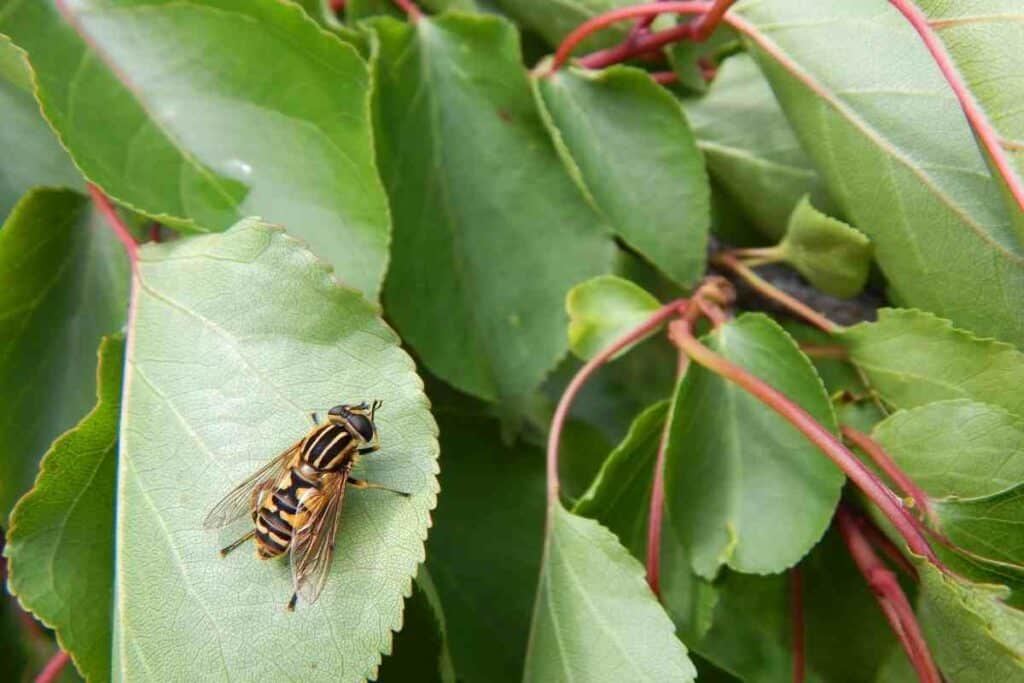
One theory as to why they come up second to bees is that their bodies carry much less pollen per flower visit than bees can.
Having said that, they do make more frequent visits to flowers, so they perhaps compensate somewhat for this.
Like Other Pollinators – Hoverflies are not too fussy when it comes to where they source their nectar. However, some species are a little fussier! The Cheilosia albitarsis species of hoverfly is one of the fussiest of all, choosing only to visit a single plant species Ranunculus repens.
Other species prefer other flowers but generally, hoverflies are thought to prefer yellow and white colored flowers.
The hoverflies’ olfactory system is able to identify these flowers.
Many species also feed on flowers that are more open as they have shorter mouths that are not quite as specialized for deeper foraging.
Given that hoverflies themselves are often a good mimic of another species, they’re also a ‘victim’ of mimicry too!
Some hoverfly species have a fascinating relationship with some species of orchid.
The Epipactis veratrifolia orchid mimics the specialized ‘alarm’ pheromones that aphids emit, attracting hoverflies to their flowers!
Controlling Pests
As mentioned, the larvae of some hoverfly species prey upon soft-bodied insects such as leafhoppers and aphids.
Given that these are considered garden pests that can spread diseases like curly top, they are a natural way of reducing pest levels.
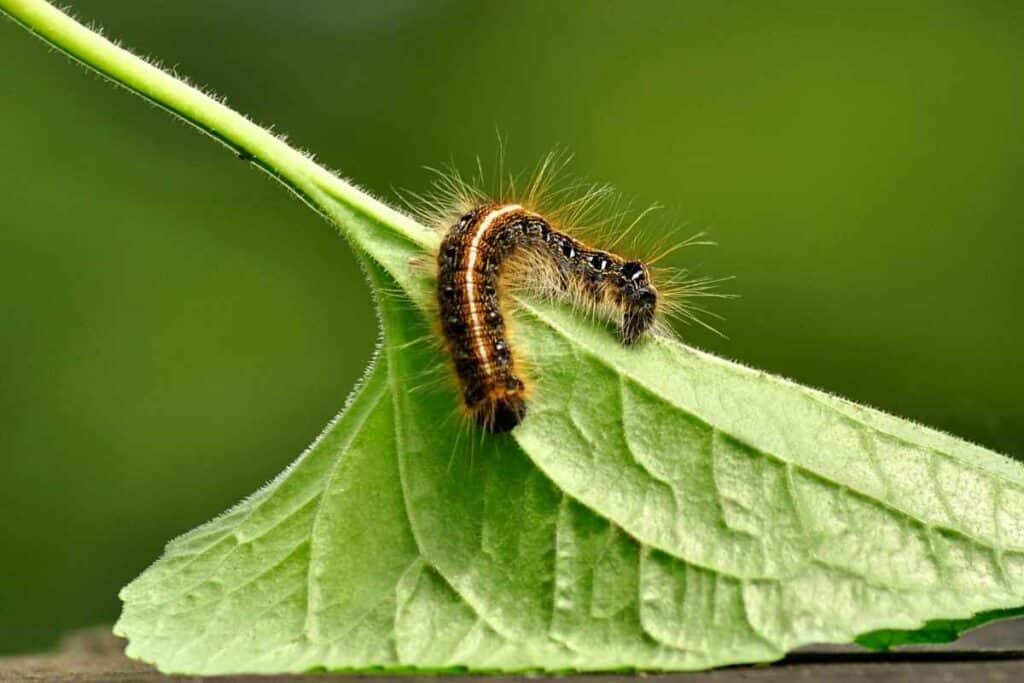
Research shows that hoverfly larvae can consume between 70 and 100% of the aphids within their vicinity.
Other pests that hoverfly larvae help to control include:
- Whiteflies
- Mealybugs
- Thrips
- Scales
- Caterpillars
Attracting Hoverflies
Many gardeners choose plants specifically to attract hoverflies to their garden in the hope that they’ll keep the pests under control.
Plants such as chamomile, yarrow, parsley, statice, and buckwheat all attract hoverflies and are used in many gardens for this reason.
Other varieties of plants that attract these insects include:

Hoverfly flower favorites for the garden to encourage their visits include:
- Daisies
- Cosmos
- Alyssum
- Aster
- Marigolds
- Coreopsis
- Zinnia
- Sunflowers
Some types of hedges and weed species are also firm favorites of the hoverfly, like ivy, dandelion, bugleweed, knapweed, Mexican Orange hedge, Bird Cherry hedge and Laurel.
Even the smallest of gardens can still attract over 20 species of hoverflies with the right planting and conditions.
Their numbers are at their highest in the alter mornings on warm and sunny days.
Common Species of Hoverfly in the US
Hoverflies number in the thousands when it comes to species.
Here are some of the most common species of hoverfly found in US gardens.
Holarctic Pied Hoverfly (Scaeva pyrastri)
This species of hoverfly reaches lengths of between 11 and 15 millimeters.
It has three distinct pairs of lunules (white markings in a comma shape) on its abdomen. It has a yellow face and reddish-brown antennae with hair-covered eyes.
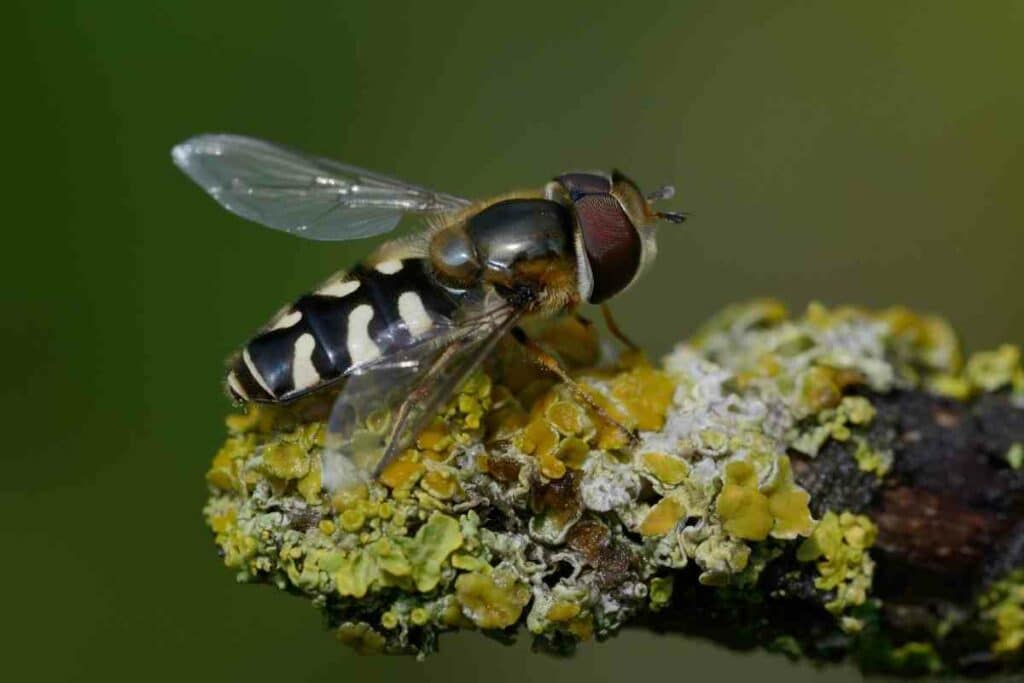
It has red legs with a black base at the femur. In the females, the eyes are separated whereas, in the males, they touch in the center.
Their larvae feed on aphids and are usually light green in appearance with a white stripe down the back.
This species enjoys living in meadows, wasteland, and gardens. They like to visit honeysuckle, daisy, and rape flowers as well as Apiaceae.
They are most commonly found between April and September.
Common Flower Fly (Syrphus ribesii)
This is a very common Holarctic hoverfly species.
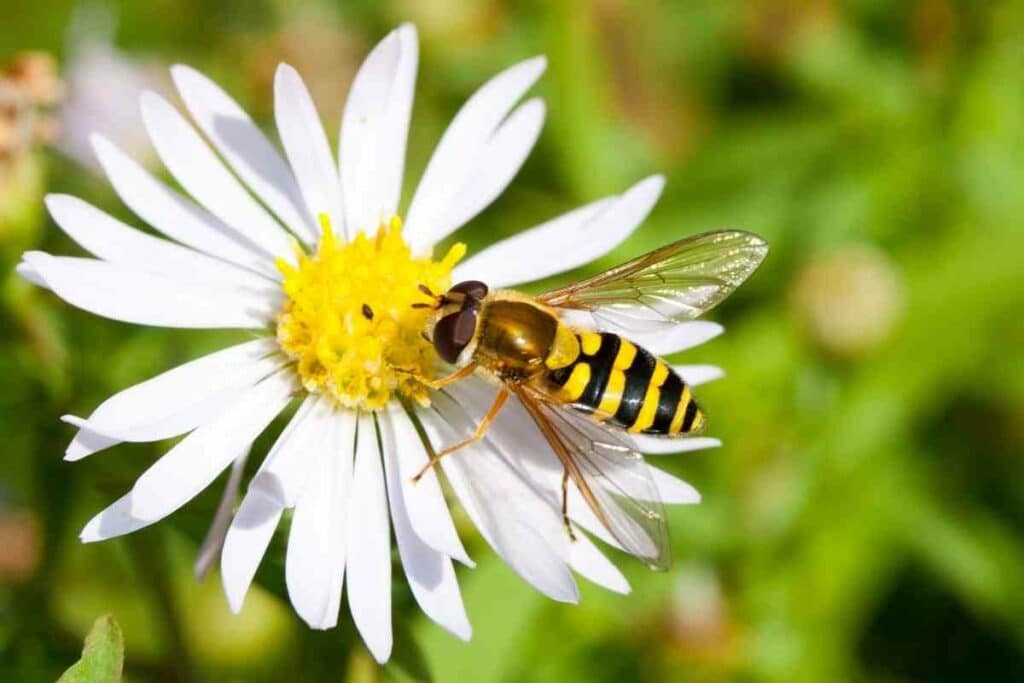
Its larvae feast on aphids and as found in many species of hoverflies, the males can be differentiated from the females by the fact that their eyes touch in the middle with the female’s eyes separated.
This species prefers living on horticultural land, farmland, and in orchards as well as parks and suburban gardens. They fly between March and mid-November.
Long Hoverfly (Sphaerophoria scripta)
This species of hoverfly can be found in most parts of the world except for extreme environments.
It reaches a length of between five and seven millimeters and has a long, narrow body with yellow and black banding.
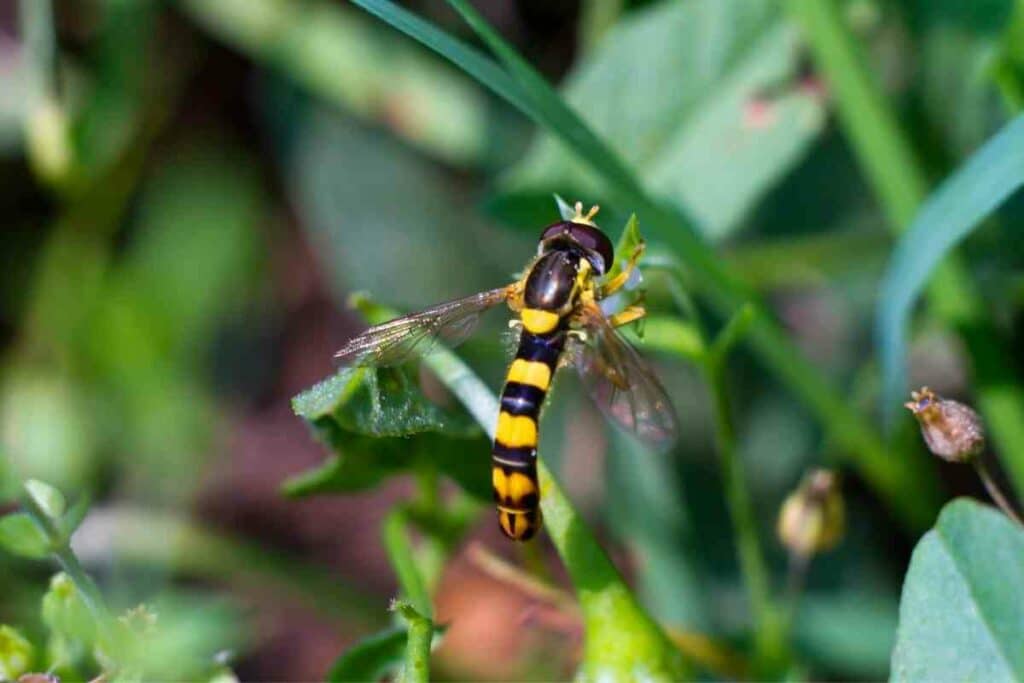
The females often appear brighter than the males as in the males the last two bands are often blurred. Its transparent wings accompany its short, yellow antennae. Its legs and face are all yellow.
Found between April and November, this species lives in gardens, flowering meadows and in thickets.
Their lifecycle is complete in as few as 16 days, with larvae feeding on aphids. Up to nine generations can appear in one year!
Palpada vinetorum
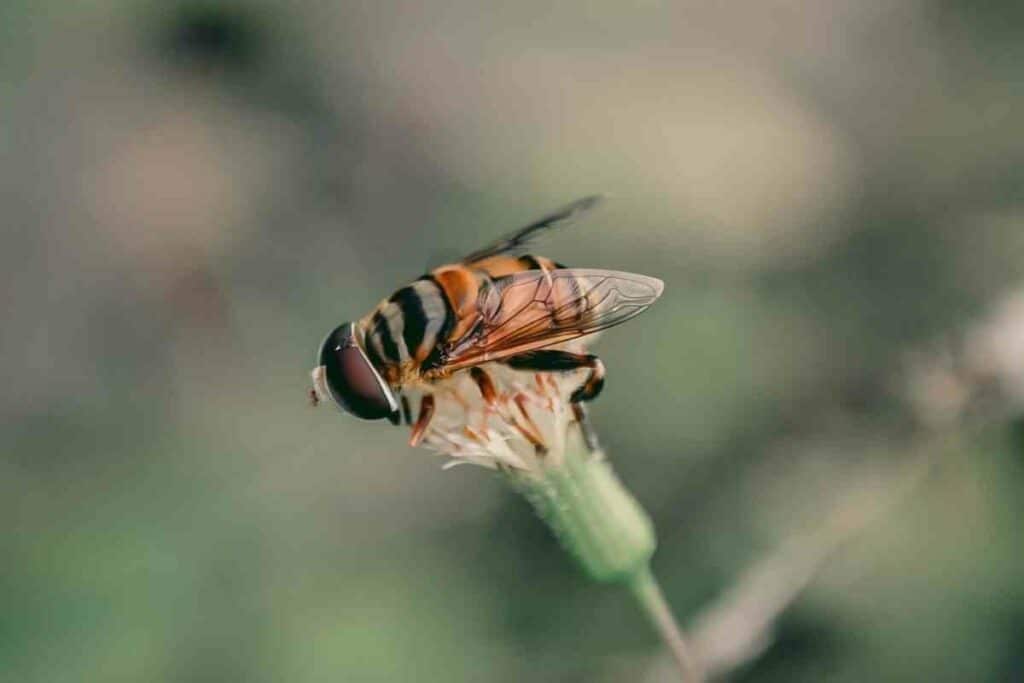
This species is native to North America but is largely found in Texas and some areas of the east coast.
It measures between 10 and 14 mm in length. It has yellow or reddish legs and a head that has a frontal triangle with white pile.
Drone Fly (Eristalis tenax)
This species is a common cosmopolitan species of hoverfly that is also migratory.
It is the most widely found syrphid species on Earth and is present in all regions except Antarctica. It was introduced to North America originally but is now widely established.
The drone fly lives in gardens and fields but has also been spotted in the Himalayas!
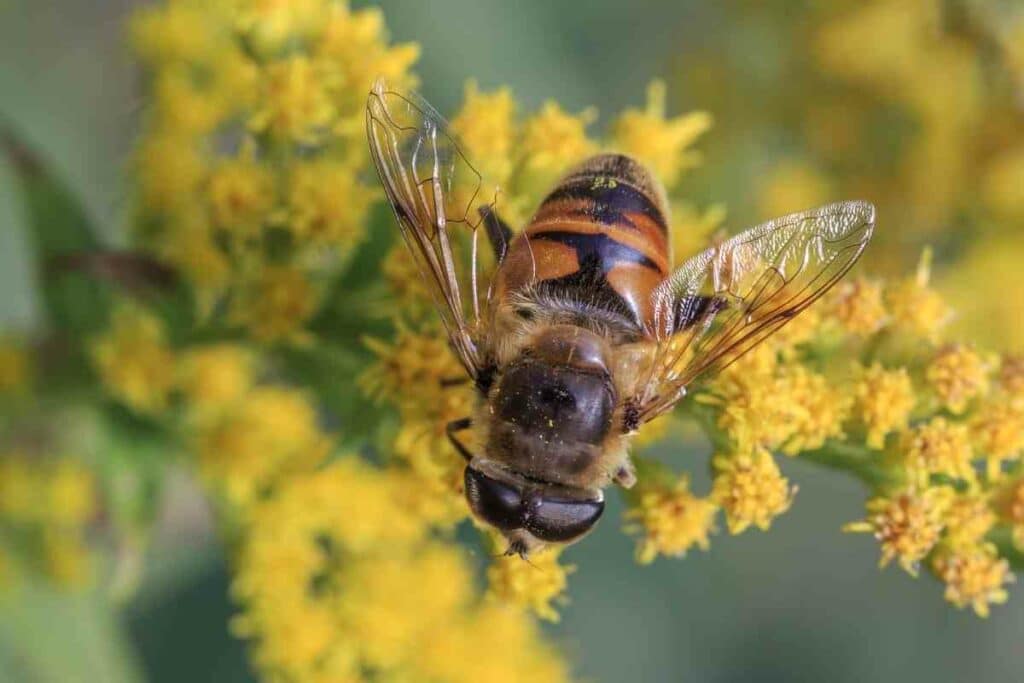
This species of hoverfly is large and stocky and is a bee mimic.
Morphologically and behaviorally, it is similar to the honeybee. This is likely due to convergent evolution thanks to their similarities in food-gathering needs.
The drone fly is most active between March and December and sometimes they outnumber honeybees, especially during the fall in more urban areas.
Males are rare in the spring as that’s when fertilized females leave hibernation.
The female tends to lay her eggs near contaminated, dirty water or even sewage as well as decomposing substances. This is because the larvae are aquatic and need organic matter for food when they emerge.
Orange-spined Drone Fly (Eristalis nemorum)
This species of hoverfly also has aquatic larvae that are of the rat-tailed maggot variety.
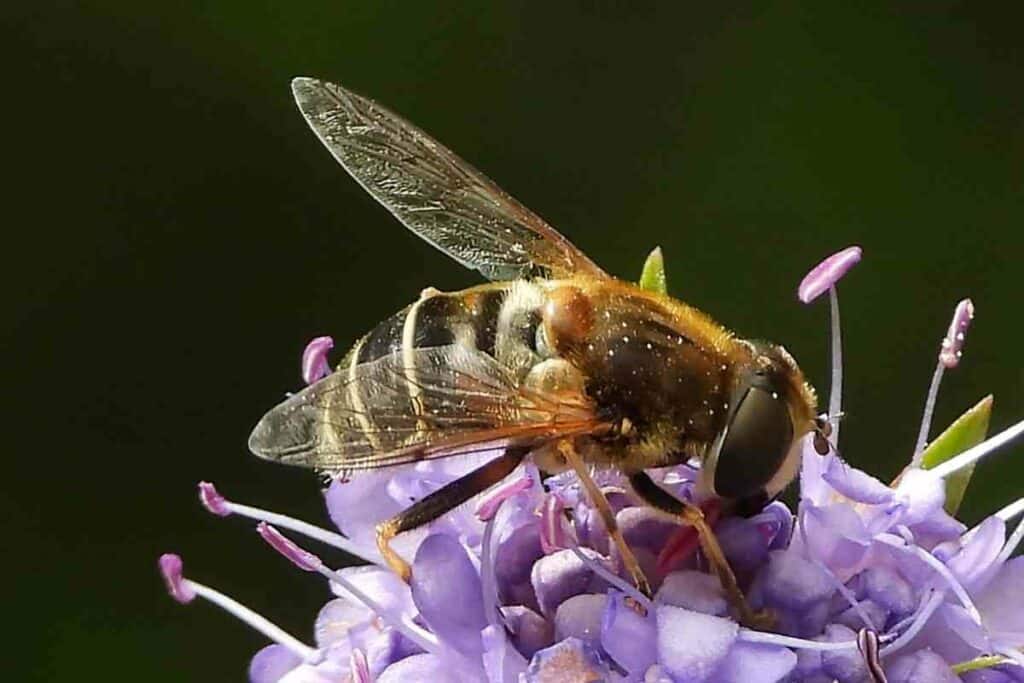
The males perform a hovering courtship display that is characteristic of the drone species. Two or more males sometimes hover over the same female.
This one likes to live near the sides of streams, poorly drained pastureland, or fen meadows.
Bumble Bee Hoverfly (Volucella Bombylans)
Found in forest clearings, hedgerows, woodland margins, and the edges of spruce forests, the bumble bee hoverfly also likes urban gardens and wasteland.
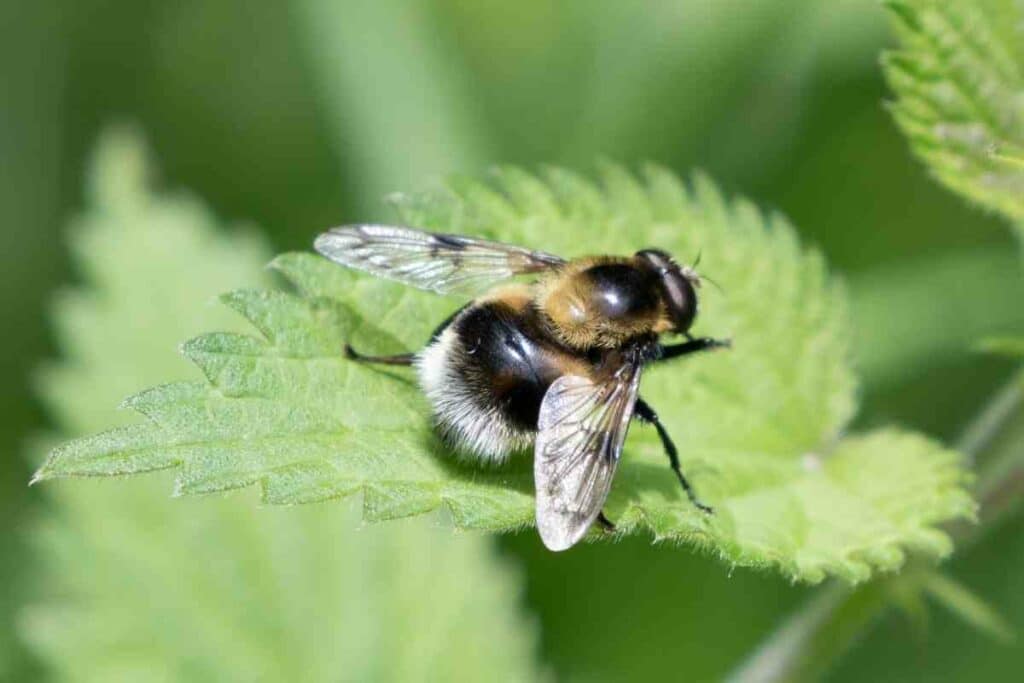
It is larger than most types of hoverflies and reaches up to 17 mm in length. As its name suggests, it rather mimics a bumble bee thanks to its fluffiness.
However, its head, plumed antennae, and wing venation reveal its true identity.
The females tend to lay their eggs in other species’ nests such as bumblebee or social wasps’ nests.
You can find these hoverflies between May and September with their peak season around June. They also prefer blue flowers.
Final Thoughts on a Gardeners’ Guide to Hoverflies
If you didn’t know it already, the humble hoverfly brings great advantages to your garden thanks to its pollination and pest-control antics!
By attracting hoverflies to your garden, you can keep pesky aphids and other pests under control as well as help other insects such as bees with the task of pollination.
What’s more, despite their mimicking appearance, they won’t sting you or your garden visitors!
